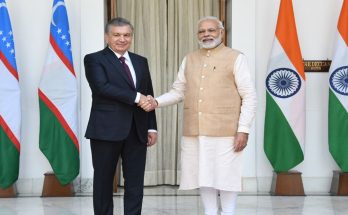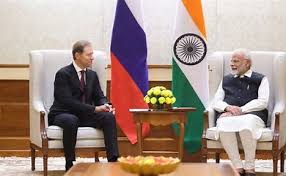Since the dawn of civilization, except for the last 250 years, Asia had half the world’s wealth and two centres of gravity – China and India. With Asia estimated to possess two-thirds of global GPD in 2050, because of favourable demographics India has the potential to overtake the United States and once again become the world’s second largest economy. As in the past the Asian giants will share this space, now requiring even closer economic integration of Asia enabled by the Asian Infrastructure Investment Bank.
The new bank
On October 24, 2014, 20 countries, including India, signed an MoU in Beijing to establish the Asian Infrastructure Investment Bank, which will have a paid up capital of $100 billion. Unlike the IMF and World Bank, no country will have a veto in this new bank. Voting rights are expected to be based on a combination of GDP and PPP, and India is expected to be the second largest shareholder. There are only three seats for non-regional countries in the Board; a sharp reversal from the current situation in multilateral financial institutions. After some initial hesitation over fears of China using the new bank to project its power in Asia, India, along with other countries in Europe and East Asia, is seeing the institution in terms of providing new economic opportunities.
Asia needs $8 trillion over the next decade and the new bank, supported by China’s reserves of $4 trillion, is a step towards meeting that requirement. So far it was not clear how this gap would be met, as the existing multilateral financial institutions had taken no initiatives apart from pointing out the need. The new bank could be the trigger, much like the Marshall Plan in post war Europe, for the Asian Century, and bring together the Asian giants.
Moving away from steps to contain China
The geo-political world order established by the United States after World War II is unravelling because of the geo-economic shift to Asia. China’s Asian Infrastructure Investment Bank has served to focus minds in Europe and East Asia. The new Bank will be a rival to the IMF and World Bank and the US risks losing its ability to shape international economic rules, and the global influence that goes with it. The UK described the new bank as an “irresistible opportunity”, which led to accusations from Washington about London’s “constant accommodation” of China, reflecting the two world-views on the emerging global order.
Since the collapse of the Soviet Union, the aim of American policy has been to prevent any power, or group of powers, from assuming hegemony in any region of the world. With the largest military in the world, the Pentagon’s strategic objectives were aligned with this goal. Consequently, the US response to the re-emergence of China as the largest economy in purchasing-power-parity terms has been to reposition two-thirds of its military assets to the Pacific as well as to extend overtures to India and nudging it into increased naval cooperation, for the purpose of containing China. So far, India has been ambivalent on its role with respect to the alliances America has with Japan and Australia; and now the latter are also questioning the US world-view.
For India, the lesson from the failed attempt by the US to obstruct the new bank is that, as Asia’s urbanization will require more than $8 trillion to be spent on infrastructure in this decade, countries in the region will welcome all the support they can get. Rather than be suspicious of China’s motives and seek to prevent the Maritime Silk Road, we should deal with the strategic concerns by joining in the development projects, for example, by providing the software packages required in the management of the ports. A mutual recognition of the special interests of each other in the South China Sea and the Indian Ocean should be a strategic objective, and will be a strategic win-win for both.
China’s “Belt and Road initiatives” are really about economic integration of Asia with the Chinese economy and the emerging Asian market, and by joining in and shaping the alignment of the rail, road, sea routes and gas pipelines (from Iran, with the impending settlement of the nuclear issue) India can become a node for Western and South Asia. Including a services component in the projects will add to their productivity and support cooperation between the Asian giants; trade is a win-win proposition.
India and China have complementary roles in the Asian Century
The global trend is that countries are gaining in influence more because of the strength of their economies than the might of their militaries, and institutions and rules serve to maintain that influence. India can either drift into the future remaining in its periphery or it can shape the future jointly with China to become one of the two engines of the Asian economy. China is likely to remain the world’s largest producer of goods and India has the potential to be the largest producer of services in the largest consumer market.
According to McKinsey and Company, the services sector will be the real driver of growth in Asia as affluence will be concentrated in cities. Digitization is challenging the way banks operate. A growing number of companies are incorporating payment processing and other financial services that have traditionally been with banks. Establishing secure data networks to enable flows across countries has emerged as a pressing need. India can match China’s expertise in infrastructure with equally important products that an urbanized Asia will need – digital governance implementing Aadhar-type cards linked with government and other services, e-commerce, low cost health treatments and pharmaceuticals, new seed varieties, are examples. India and China have evolved in complementary ways that reduces competitiveness between them.
Triumph of geo-economics
The future opportunities require a bold new vision. Firms in both countries will have to develop cooperative relationships with new mindsets and business models to make the region more open with integrated investment and trade. Asia is a dynamic and diverse market, and successful companies are already thinking about connectivity across the region. The ability to design, finance, build and implement the big data-technology systems will be the defining comparative advantage in the future, and India and China should work together to make this happen by sharing their respective expertise. The complex interdependencies will be a strong stabilizing force.
The new bank should focus on three areas defining ‘infrastructure” broadly to enhance productivity. First, a “Digital Asia initiative” to complement the ‘Road and Belt Initiative”; second, developing Shanghai and Mumbai as truly global cities and financial centres, to leverage capital; and, third, jointly establish a think-tank in Delhi, on the lines of the OECD, to provide a forum where Asian governments work together to analyse data to predict future trends, develop standards for Asia, seek solutions to improve the quality of life and provide inputs to governments and to the new bank. The new world order will not only need new institutions but also new norms, rules and practices.
According to Prime Minister Modi, China and India are “two bodies, one spirit”, and for his part President Xi has emphasised the “need to become global partners having strategic coordination”. India’s National Security Adviser has expressed satisfaction with the progress of the border talks, where agreement was reached to maintain peace and expedite a solution that is fair. The Chinese Premier has also suggested a triangular partnership with respect to Sri Lanka which would include India and it is now for us to flesh this out. The new bank provides a new opportunity for the two Asian giants to work together for their future prosperity, and make the Asian Century a reality.
Views expressed are of the author and do not necessarily reflect the views of the IDSA or of the Government of India
(Courtesy: IDSA)
Author Profile
- India Writes Network (www.indiawrites.org) is an emerging think tank and a media-publishing company focused on international affairs & the India Story. Centre for Global India Insights is the research arm of India Writes Network. To subscribe to India and the World, write to editor@indiawrites.org. A venture of TGII Media Private Limited, a leading media, publishing and consultancy company, IWN has carved a niche for balanced and exhaustive reporting and analysis of international affairs. Eminent personalities, politicians, diplomats, authors, strategy gurus and news-makers have contributed to India Writes Network, as also “India and the World,” a magazine focused on global affairs.
Latest entries
 DiplomacyOctober 4, 2025UNGA Resolution 2758 Must Not Be Distorted, One-China Principle Brooks No Challenge
DiplomacyOctober 4, 2025UNGA Resolution 2758 Must Not Be Distorted, One-China Principle Brooks No Challenge India and the WorldJuly 26, 2025MPs, diplomats laud Operation Sindoor, call for national unity to combat Pakistan-sponsored terror
India and the WorldJuly 26, 2025MPs, diplomats laud Operation Sindoor, call for national unity to combat Pakistan-sponsored terror India and the WorldJuly 25, 2025When Fire Ends, Diplomacy Begins
India and the WorldJuly 25, 2025When Fire Ends, Diplomacy Begins India and the WorldJuly 16, 2025Operation Sindoor and its Aftermath: India’s Successful Diplomatic Outreach
India and the WorldJuly 16, 2025Operation Sindoor and its Aftermath: India’s Successful Diplomatic Outreach







